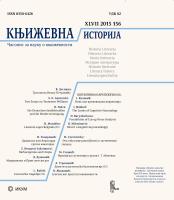Оквири у когнитивној наратологији
Frames in Cognitive Narratology
Author(s): Dejan D. MilutinovićSubject(s): Language and Literature Studies, Studies of Literature, Theory of Literature
Published by: Институт за књижевност и уметност
Keywords: cognitive narratology;frames;scripts;conceptual blending;understanding text/discourse;
Summary/Abstract: This paper deals with the concept of frames and their application in narratologicalresearch. The first part offers an overview of this concept’s origin history, from the beginnings in the work of Bateson and Goffman, to the formulation posited by Marvin Minsky – that frames enable interpretation both of reality and artefacts and the use of other concepts in perception, experience and communication ,i.e. that they are the basic means of navigation in the experience universe, thepreconditions for cognitive activities of interpretation. Subsequently, we present how this concept was introduced into narratology, most importantly in the works of Catherine Emmot and Werner Wolf. Apart from that, we discuss the conceptual blending theory which bases its approach precisely on frames. The second part of the paper shows, via the case study method and the use of the conceptual blending theory i.e. the use of frames (and scripts) as analytic instruments, the possibility of understanding Vladimir Kecmanović’s novel "Top je bio vreo" ["The Cannon Was Hot"]. The author starts with the assumption that frames are contextual categories not only related to the existing cognitive ideas predetermining reception, but also building context, i.e. the frame of the storyworld, on the basis of its scripts. That means they are activated during the reception of story segments and depending on it, but also re-evaluated and finally established after the story’s end, and thus can be examined as initial, medial and final frames. Initial frames are the preconceptions that the reception begins with. Medial are those frames that are established by the development of the story’s events, and the final ones commence after the story’s ending, when, on the basis of the created and accepted world, we establish a “final” cognitive notion of the reception’s object, which may alter the previously used frames. In the analysis of "Top je bio vreo", the initial frames concern extratextual frames, most importantly as regards the historical context,but also intertextual frames related to the genre-discourse frames. Medial frames are linked to those that depict and accept parts of the storyworld. The final frames subsume the conceptual blending of psycho-philosophical (meta)concepts that form the basis for the novel’s understanding and interpretation and are established with consideration of the syuzhet’s closure and the novel’s ending. Finally, the author posits a formula showing how the understanding of text/discourse is performed by means of frames, i.e. by means of conceptual blending: every conceptual blending is correct when some of the elements of offered text/discourse overlaps with some of the elements of the text/discourse in the recipient’s memory, if and only if the intersection of those elements exceeds the offered and existing (recipient’s) text/discourse.
Journal: Књижевна историја
- Issue Year: 47/2015
- Issue No: 156
- Page Range: 63-79
- Page Count: 16
- Language: Serbian

